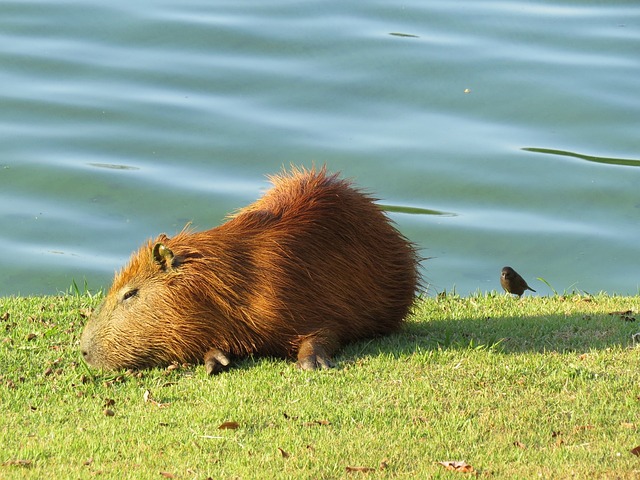Capybaras have captivated the interest of the internet with their seemingly sociable behaviors, particularly with regards to their interactions with each other and different species.
Among the many images and videos that have been circulated online, some depict capybaras in close physical contact, sometimes even appearing to be stacked on top of one another.
These visuals have prompted questions about the nature of this behavior and whether it is a common or widely misunderstood aspect of their social habits.
While the images of capybaras “stacking” have become popular, it is essential to distinguish between what is typical behavior in the wild and what might be anthropomorphized or rare occurrences.
While research on capybaras does confirm their close and often physical social structures, there is limited evidence of regular stacking behavior as portrayed on social media.
It is more common to observe these animals lounging in proximity, sometimes with slight overlaps as they rest or interact within their groups. It is important to approach such claims with a critical perspective and an understanding that isolated behaviors captured in images or videos do not necessarily reflect the normal practices of a species.
Capybara Behavior
Capybaras exhibit intricate behaviors characterized by a complex social structure and diverse communication methods. Understanding these behaviors provides insight into their day-to-day interactions within their natural habitat.
Social Structure
Capybaras are highly social rodents that live in groups ranging from 10 to 30 individuals, although some group sizes can swell up to 100 during the dry season. These groups usually consist of one dominant male, several females, their young, and subordinate males. The dominant male asserts his status through specific behaviors such as scent-marking with glandular secretions and physical displays of dominance.
- Group Composition:
- Dominant male: 1
- Females: Multiple
- Juveniles: Variable
- Subordinate males: Several
- Habitat use:
- Dry season: Groups congregate around water sources.
- Wet season: Groups disperse for foraging.
Communication Methods
Capybaras communicate through a variety of vocalizations and body languages. Vocal communications include purring to express contentment and sharp barks as alarm calls. They utilize scent marking for both social structuring within the group and territorial purposes. Body postures, such as standing on their hind legs or exposing their teeth, serve as both aggressive and submission indicators within their hierarchical community.
- Vocalizations:
- Contentment: Purring
- Alarm: Sharp barks
- Scent marking purposes:
- Social: Establishing hierarchy within the group.
- Territorial: Delineating occupied space.
Capybara Habitat
Capybaras thrive in regions close to bodies of water, which are crucial for their habitat. These semi-aquatic mammals prefer areas where water and land meet, providing them with necessary resources for their diet and protection against predators.
Geographical Range
Capybaras are native to several countries in South America. They can be found from the north in Colombia and Venezuela down through Brazil, Argentina, and Uruguay. Their presence is widespread, mainly in the Amazon basin, which provides the perfect balance between land and water for their needs.
Key Locations:
- Colombia
- Venezuela
- Brazil
- Argentina
- Uruguay
Environmental Preferences
These animals demonstrate a strong preference for wetlands, swamps, riversides, and estuaries where they can easily access the water for escaping predators and foraging aquatic plants. Capybaras are herbivores, and their diet mainly consists of grass and aquatic vegetation.
Habitat Characteristics:
- Wetlands: High humidity and abundant vegetation.
- Swamps: Muddy areas with waterlogged soil.
- Riversides: Adjacent to slow-moving waters.
- Estuaries: Brackish water areas with diverse plant life.
Myths and Truths
Capybaras have been a subject of various myths, particularly concerning their behavior. This section dispels those myths and explains the origins of one particular behavior.
Common Misconceptions
One prevalent myth about capybaras is that they stack on top of each other to sleep or rest. In truth, while they are highly social creatures, they do not form vertical piles. They may be seen lying close together or even sprawled over one another in a relaxed state, but this should not be mistaken for intentional stacking.
Here is a simple breakdown of common misconceptions:
- Myth: Capybaras create tower-like structures by stacking.
- Fact: Capybaras rest near each other without forming deliberate stacks.
Stacking Behavior Origins
The idea that capybaras stack could have originated from misinterpreted photos or videos circulating online. These often show capybaras in close contact, sometimes in what appears to be a stack due to perspective. It’s important to understand that capybaras exhibit a range of social behaviors:
- Lounging in groups for warmth and safety.
- Climbing over one another as an expression of curiosity and play.
- Huddling together as part of their social structure.
Their tendency to cluster is based on the comfort and security of being part of a group, rather than a deliberate attempt to create a stack.




